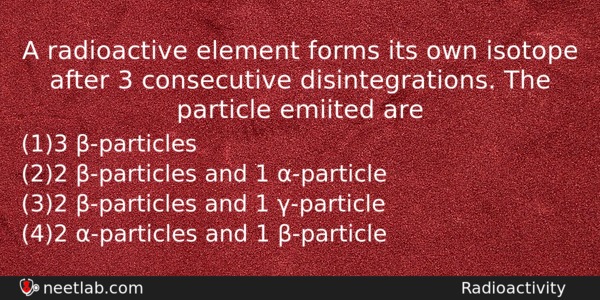| ⇦ | 
| ⇨ |
A radioactive element forms its own isotope after 3 consecutive disintegrations. The particle emiited are
Options
(a) 3 β-particles
(b) 2 β-particles and 1 α-particle
(c) 2 β-particles and 1 γ-particle
(d) 2 α-particles and 1 β-particle
Correct Answer:
2 β-particles and 1 α-particle
Explanation:
No explanation available. Be the first to write the explanation for this question by commenting below.
Related Questions: - A bullet emerges from a barrel of length 1.2 m with a speed of 640 ms⁻¹.
- At a metro station, a girl walks up a stationary escalator in time t₁
- An avarage induced e.m.f. of 1 V appears in a coil when the current in it is changed
- Which of the following is suitable for the fusion process?
- In Young’s double slit experiment, the intensity of light coming from the first slit
Topics: Radioactivity
(83)
Subject: Physics
(2479)
Important MCQs Based on Medical Entrance Examinations To Improve Your NEET Score
- A bullet emerges from a barrel of length 1.2 m with a speed of 640 ms⁻¹.
- At a metro station, a girl walks up a stationary escalator in time t₁
- An avarage induced e.m.f. of 1 V appears in a coil when the current in it is changed
- Which of the following is suitable for the fusion process?
- In Young’s double slit experiment, the intensity of light coming from the first slit
Topics: Radioactivity (83)
Subject: Physics (2479)
Important MCQs Based on Medical Entrance Examinations To Improve Your NEET Score
18000+ students are using NEETLab to improve their score. What about you?
Solve Previous Year MCQs, Mock Tests, Topicwise Practice Tests, Identify Weak Topics, Formula Flash cards and much more is available in NEETLab Android App to improve your NEET score.
Share this page with your friends

Leave a Reply